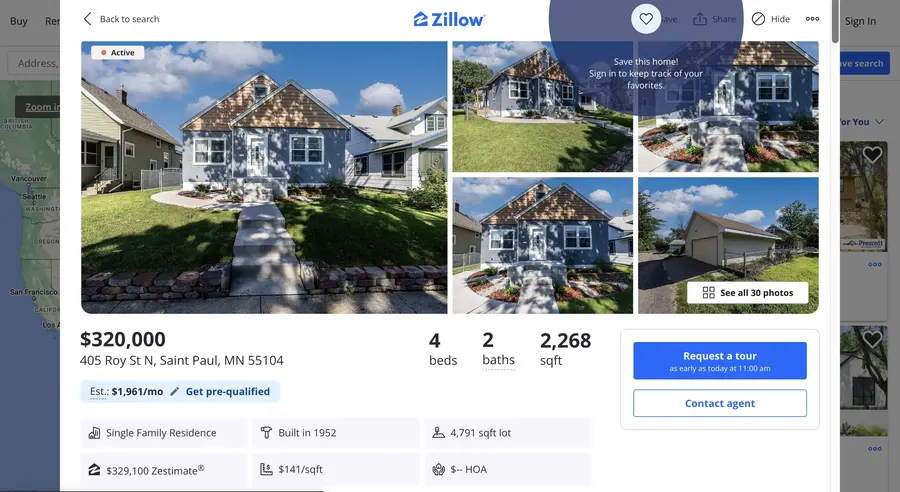Aspiring to reshape how people experience real estate? Crafting a digital platform akin to Zillow demands a strategic blend of technology and market acumen. This in-depth guide unravels the complexities of constructing a robust real estate website, from its foundational architecture to its revenue-generating mechanisms. Discover how to position your brand amidst industry giants and unlock the potential to revolutionize the way people search for their dream homes.
How real estate websites like Zillow works

Imagine a giant pipeline with data flowing through it. That’s essentially how websites like Zillow operate. Here’s a detailed flow of how it works, from database to showing everything on frontend.
Step 1: It all starts from data
At the heart of these platforms lies a massive database brimming with property details, high-quality photos, and precise location data. This information is meticulously gathered from multiple sources, including:
- Multiple Listing Services (MLS): The primary source for most property listings.
- Public Records: Government-maintained records of property ownership, deeds, and assessments.
- Partnerships: Collaborations with other data providers, such as tax assessors or geographic information systems (GIS).
For instance, you need to have a rich data set like the following example, with all the necessary details properly mentioned. You can find such data from websites like this one » Real estate dataset catalog of US gov.

Step 2: Transforming raw data into insights
Raw data is like crude oil, it needs refining before it's valuable. Data processing is where this transformation occurs. Advanced algorithms are developed to automate the following tasks:
- Categorize properties: Sorting homes into types like single-family, condo, or townhouse.
- Estimate market value: Using complex models to predict a property's worth.
- Ensure data accuracy: Identifying and correcting errors or inconsistencies.
Note: Make sure you try to automate every step possible to reduce redundant & time consuming tasks. It will help you build a sustainable real estate website & processes.
Step 3: The user experience & front-end
The processed information from Step 2 is then presented through the user interface - the website or app you interact with. It’s designed to be intuitive and user-friendly, offering features like:
- Search filters: Refining results based on location, price range, property type, number of bedrooms, and more.
- Interactive maps: Visually exploring neighborhoods and property locations.
- Detailed property listings: Showcase property features, photos, virtual tours, and neighborhood information.
We will get into the details of these sections in the coming sections.
Step 4: Matching users with their dream home
The magic happens when users start searching. The platform's algorithms diligently match user search needs with available listings. Zillow is particularly adept at this, offering granular filters that allow users to specify preferences down to the smallest detail.
Step 5: Connecting buyers and sellers
Once you've found a potential home, the platform facilitates easy communication with the listing agent. Contact forms and direct links are typically provided, streamlining the process of inquiring about a property.
In essence, real estate websites like Zillow are sophisticated data management systems that create a seamless experience for users looking to buy, sell, or rent property.
Revenue models of real estate websites
Real estate websites have several avenues to generate income. Let's break down the common models:
Paid featured listings
To gain a competitive edge, real estate agents often opt for premium listings. These listings are strategically placed in prominent positions on search results, increasing their visibility to potential buyers or renters. This service comes at a premium, with agents paying a fee for the enhanced exposure. Zillow is a well-known example of a platform that offers this service.
Lead generation
A significant revenue source is lead generation. Real estate websites act as a bridge between potential buyers/renters and real estate agents. By capturing user information and preferences, these platforms can match interested individuals with suitable agents. A fee is typically charged to agents for each qualified lead generated.
Advertising
Online advertising is a cornerstone of revenue for many real estate websites. By displaying targeted ads for mortgage lenders, home improvement services, moving companies, and other related businesses, these platforms generate income. Zillow is a prime example of a website that heavily relies on advertising to fuel its growth.
Transaction fees
While less common, some real estate websites implement a transaction fee model. This involves charging a commission on successful property transactions facilitated through the platform. This fee can be a percentage of the sale price or a flat rate.
Note: It's important to note that many real estate websites employ a combination of these revenue streams to maximize their earnings.
Which revenue model does Zillow follow?
Zillow primarily operates on a hybrid revenue model. This means it combines multiple revenue streams to generate income. Key components of Zillow's revenue model include:
- Advertising-based model
Premier Agent Advertising: This is Zillow's core revenue driver, where real estate agents pay for prominent placement in search results.
Display Advertising: Zillow sells advertising space to mortgage lenders, home improvement companies, and other related businesses.
- Transaction-based model
Lead Generation: Zillow charges real estate agents and property management companies for leads generated through the platform.
- Subscription-based model
Mortgage Services: By connecting users with mortgage quote services, Zillow generates revenue through subscription fees or referral commissions.
It's interesting to see that Zillow has successfully created a multi-sided marketplace that brings together homeowners, renters, real estate agents, and businesses. By offering a variety of monetization strategies, Zillow has solidified its position as a dominant player in the real estate industry.
While the foundation of Zillow's business is advertising, the inclusion of transaction-based and subscription-based revenue streams adds depth and resilience to its overall financial performance.
Important functionalities of a real estate website like zillow
A successful real estate website, like Zillow or Redfin, requires a robust set of features to attract and engage users. Let's delve deeper into these core functionalities:
Property dataset & listing management
This is the backbone of any real estate platform. It involves creating a comprehensive database to store property details, including descriptions, high-quality images, virtual tours, and floor plans. The system should allow agents and property owners to easily input and manage their listings.
Advanced search functionality
A powerful search engine is crucial. Users should be able to filter properties based on various criteria such as location, price range, property type, number of bedrooms, bathrooms, square footage, amenities, and more. Implementing advanced search filters enhances user experience and helps them find their ideal property quickly.

Interactive maps
Integrating a detailed map allows users to visualize property locations and explore neighborhoods. Features like zoom, street view, and property markers enhance the user experience.
User profiles and saved searches
By enabling users to create accounts, real estate websites can personalize the experience. Users can save their favorite properties, set up email alerts for new listings matching their criteria, and track their property search history.
Communication tools
Effective communication between buyers, sellers, and agents is essential. Integrating contact forms, messaging systems, or even video conferencing capabilities can streamline the process.
Market insights and analytics
Providing valuable market data, such as price trends, home values, and neighborhood information, helps users make informed decisions. Mortgage calculators and affordability tools are additional valuable resources.
Mobile optimization
Given the increasing use of smartphones, a mobile-friendly website or a dedicated app is crucial. Users should be able to search for properties, view details, and contact agents on the go. You can outsource this work to an app development company that specializes in building robust mobile apps.
Additional features to consider (optional)

Virtual tours:
Immersive virtual tours can significantly enhance the property viewing experience, allowing users to explore properties remotely.
User reviews and ratings:
Incorporating a review system for properties and agents can build trust and credibility.
Property comparisons:
Enabling users to compare multiple properties side-by-side can help them make informed decisions.
Social media integration:
Integrating social media platforms can increase reach and engagement.
Lead management tools:
For agents, providing tools to manage and nurture leads can improve conversion rates.
By implementing these features, a real estate website can create a seamless user experience, attract a wider audience, and drive engagement.
How much does it cost to create/build a website like zillow
Developing a real estate platform with the complexity and features of Zillow is a significant undertaking that comes with substantial costs. The exact figure can vary widely based on several factors like these:
- Scope and Features
A fundamental platform with basic functionalities will be less expensive than a comprehensive platform offering advanced features like Zillow. Factors such as virtual tours, advanced search filters, and complex data analytics directly impact costs. - Development Approach
Building from scratch offers maximum customization but requires a larger development team and more time, leading to higher upfront costs. Another option is to use a website builder. It is more restrictive in terms of customization, website builders can be cost-effective for basic platforms. The last and most economical option is using pre-built templates. These provide a starting point, but significant customization might still be necessary, affecting overall costs.
- Technology Stack
The choice of programming languages, frameworks, and tools influences development costs. - Design and User Experience (UX)
A visually appealing and user-friendly interface is crucial. Investing in professional design and UX expertise can increase costs. - Data Acquisition and Integration
Gathering and integrating data from various sources (MLS, public records, etc.) requires significant resources and time. - Misc Costs:
- Maintenance: Regular updates, bug fixes, and security patches are essential.
- Hosting and domain: These are ongoing expenses.
- Data management: Storing and managing large amounts of data requires infrastructure and personnel.
Cost Estimates
While providing a precise figure is challenging without specific project details, here's a general estimate:
- Basic platform: $5,000 - $25,000
- Mid-sized platform: $30,000 - $80,000
- Zillow-like platform: $100,000+
It's essential to note that these are rough estimates. The actual cost can fluctuate significantly based on the factors mentioned above.
To get a more accurate cost estimate for your specific project, it's recommended to consult with development agencies or freelancers who specialize in real estate platforms. They can provide detailed cost breakdowns based on your requirements. Or you can contact us to get a detailed and budget friendly estimate.
How to position your real estate brand uniquely

The real estate market is crowded with established players like Redfin, Realtor.com, and Homes.com. So, how do you carve out your own niche and attract users to your website? Here are some unconventional approaches you can consider:
1. Hyperlocal Expertise
Go beyond "city-level" targeting. Focus on specific neighborhoods, becoming the go-to resource for buyers and sellers within those micro-markets. Partner with local businesses, create detailed neighborhood guides highlighting unique amenities, and showcase hyperlocal market trends.
2. Curated Experience
Cater to specific buyer personas with a focus on curated listings. Offer curated collections for "first-time buyers," "design enthusiasts," or "sustainability-conscious investors." Utilize AI and machine learning to personalize search results and property recommendations based on user preferences and past behavior.
3. Community-driven Approach
Foster a sense of community and build trust beyond simple listings. Integrate social media features for users to connect, share local recommendations, and engage in discussions about specific neighborhoods. Partner with local influencers and host online or offline events to cultivate a vibrant community around your brand.
4. Immersive Storytelling
Go beyond static photos and basic descriptions. Experiment with interactive content like 360-degree virtual tours, 3D floor plans, and even augmented reality (AR) experiences that allow users to "virtually stage" furniture in potential properties.
Need Help With building a real estate website?
Building a real estate website that stands out in today's competitive market requires a strategic approach and technical expertise. That's where PragetX comes in.
As a leading web development company specializing in real estate platforms, we offer comprehensive solutions tailored to your specific needs. Our team of experienced professionals will guide you through every step of the process, from initial concept to launch and beyond.





